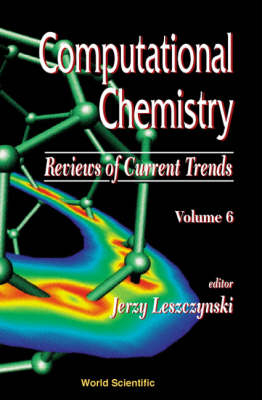
Computational Chemistry: Reviews Of Current Trends, Vol. 6
Seiten
2001
World Scientific Publishing Co Pte Ltd (Verlag)
978-981-02-4660-0 (ISBN)
World Scientific Publishing Co Pte Ltd (Verlag)
978-981-02-4660-0 (ISBN)
- Titel z.Zt. nicht lieferbar
- Versandkostenfrei innerhalb Deutschlands
- Auch auf Rechnung
- Verfügbarkeit in der Filiale vor Ort prüfen
- Artikel merken
There are strong indications that, in the 21st century, computational chemistry will be a prime research tool not only for the basic sciences but also for the life and materials sciences. This volume provides up-to-date reviews which cover representative areas of computational chemistry.
There are strong indications that, in the 21st century, computational chemistry will be a prime research tool not only for the basic sciences but also for the life and materials sciences. Recent developments in nanotechnology allow us to detect a layer of single atoms. Researchers are able not only to image but also to manipulate molecules and atoms. It does not take much imagination to realize that before performing such a task on a real system it is much easier and faster to study models on computers. That is the aim of this volume — it provides up-to-date reviews which cover representative areas of computational chemistry.In Chapter 1, Y Ishikawa and M J Vilkas provide a review of multireference Moller-Plesset (MR-MP) perturbation theory. Fifteen years ago Roberto Car of Princeton University and Michele Parrinello of Max Planck Institute introduced a method that revolutionized electronic structure calculations for molecules, liquids and solids. Ursula Rothlisberger, a former member of Parrinello's group, reviews the formation of the method in its most common implementations in Chapter 2. In the third chapter, Isaac B Bersuker describes the general theory of the combined quantum mechanics-molecular mechanics (QM/MM) approach. In Chapter 4, Marcel Allavena and David White present a review of applications of computational chemistry to proton transfer, the primary process for acid-base chemistry on zeolites. Chapter 5 is a review by S Roszak and J Leszczynski of recent data on the clusters formed from the charged ion and weakly interacting ligands. The last chapter, contributed by Carlos R Handy, is devoted to recent developments in the incorporation of continuous wavelet transform analysis into quantum operator theory.
There are strong indications that, in the 21st century, computational chemistry will be a prime research tool not only for the basic sciences but also for the life and materials sciences. Recent developments in nanotechnology allow us to detect a layer of single atoms. Researchers are able not only to image but also to manipulate molecules and atoms. It does not take much imagination to realize that before performing such a task on a real system it is much easier and faster to study models on computers. That is the aim of this volume — it provides up-to-date reviews which cover representative areas of computational chemistry.In Chapter 1, Y Ishikawa and M J Vilkas provide a review of multireference Moller-Plesset (MR-MP) perturbation theory. Fifteen years ago Roberto Car of Princeton University and Michele Parrinello of Max Planck Institute introduced a method that revolutionized electronic structure calculations for molecules, liquids and solids. Ursula Rothlisberger, a former member of Parrinello's group, reviews the formation of the method in its most common implementations in Chapter 2. In the third chapter, Isaac B Bersuker describes the general theory of the combined quantum mechanics-molecular mechanics (QM/MM) approach. In Chapter 4, Marcel Allavena and David White present a review of applications of computational chemistry to proton transfer, the primary process for acid-base chemistry on zeolites. Chapter 5 is a review by S Roszak and J Leszczynski of recent data on the clusters formed from the charged ion and weakly interacting ligands. The last chapter, contributed by Carlos R Handy, is devoted to recent developments in the incorporation of continuous wavelet transform analysis into quantum operator theory.
Relativistic multi-reference Moeller-Plesset perturbation theory, Y. Ishikawa and M.J. Vilkas; 15 years of Car-Parrinello simulations in physics, chemistry and biology, U. Rothlisberger; methods of combined quantum/classical (QM/MM) modelling for large organometallic and metallo-biochemical systems, I.B. Bersuker; a review of ab initio calculations on proton transfer in zeolites, M. Allavena and D. White; ionic clusters with weakly interacting components - magic numbers rationalized by the shell structure, S. Roszak and J. Leszczynski; turning point quantization and scalet-wavelet analysis, C.R. Handy.
| Erscheint lt. Verlag | 29.8.2001 |
|---|---|
| Reihe/Serie | Computational Chemistry: Reviews Of Current Trends ; 6 |
| Verlagsort | Singapore |
| Sprache | englisch |
| Themenwelt | Naturwissenschaften ► Chemie |
| ISBN-10 | 981-02-4660-9 / 9810246609 |
| ISBN-13 | 978-981-02-4660-0 / 9789810246600 |
| Zustand | Neuware |
| Haben Sie eine Frage zum Produkt? |
Mehr entdecken
aus dem Bereich
aus dem Bereich
Introduction for Scientists and Engineers
Buch | Softcover (2024)
Wiley-VCH (Verlag)
119,00 €


